Strength, organization, divisions and equipment of the Army, Colonial Troops and Fascist Milita as Italy entered the Second World War in June 1940.
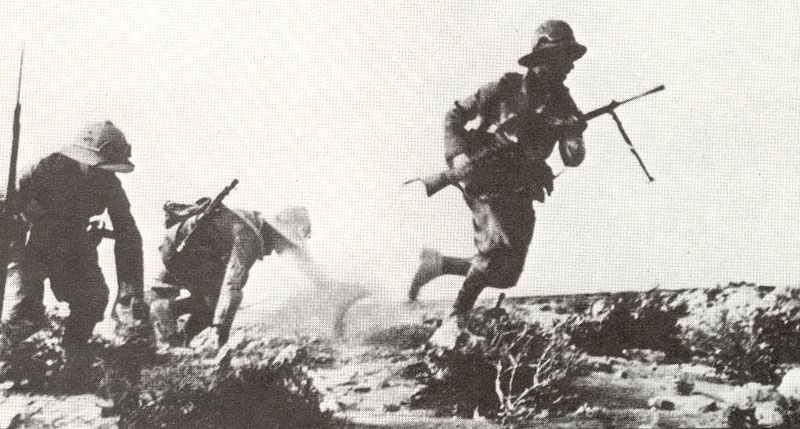
Italian Army in WW2
Table of Contents
The Italian Army during World War II played a significant role in the conflict, although it faced numerous challenges and setbacks.
Overview
Size: At its peak, the Italian Army had around 1.7 million men under arms.
Equipment: The army was often poorly equipped compared to other major powers, with outdated weapons and vehicles.
North African Campaign: Italy fought alongside Germany in North Africa, initially against British forces and later against American forces as well.
Invasion of Greece: In 1940, Italy invaded Greece but was pushed back, requiring German intervention.
Eastern Front: Italy sent forces to support Germany’s invasion of the Soviet Union in 1941.
Mediterranean Theater: The Italian Army was involved in defending Italy and its territories in the Mediterranean.
Allied invasion of Sicily: In 1943, Allied forces invaded Sicily, leading to the collapse of Mussolini’s government.
Armistice and split: After Italy’s surrender in September 1943, the army split between those loyal to the new government (co-belligerent with the Allies) and those supporting the German-backed Italian Social Republic.
Partisan warfare: Many former Italian soldiers joined partisan groups fighting against German occupation after 1943.
Performance: The Italian Army’s performance was mixed, with some units fighting effectively while others suffered from low morale and poor leadership.
Overall, the Italian Army in WW2 faced significant challenges due to inadequate equipment, strategic miscalculations, and changing political circumstances as the war progressed.
The Italian Army in the first year of the war 1940-41
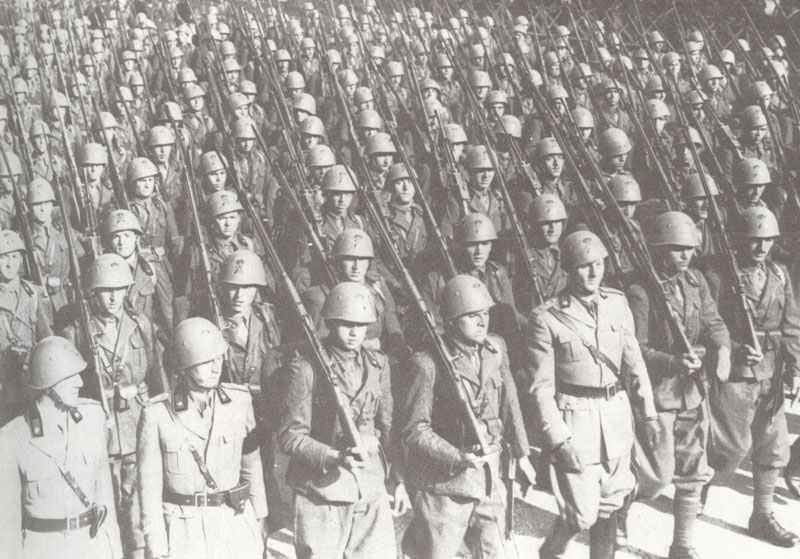
Italian Army
The Italian Army had suffered heavy losses for only limited gains during World War One and in common with the other combatant nations the Army was drastically reduced in size and influence following the 1918 armistice. But the development of the fascist corporate state in the 1920s saw a revival of the influence of the Army. The new leader of Italy, Benito Mussolini, combined an authoritarian approach to domestic affairs with an aggressive foreign policy. The Army was expanded to become the instrument of Mussolini’s territorial ambitions. In 1935 Italy invaded Ethiopia, and in April 1939 took over Albania.
Despite Mussolini’s grandiose claims, Italy did not possess the capability to wage effective war. The population was apathetic, there was a severe shortage of strategic raw materials and the Army, woefully lacking in the necessary arms and equipment, was insufficiently prepared in the techniques of modern warfare.
Italy’s entry into the war – the campaign against France from 10 to 25 June 1940 – was a humiliating fiasco, partly because strategic planning was centered on the Mediterranean, and the General Staff was caught off balance by the directives for an Alpine campaign. The Army suffered over 4,000 casualties in this brief campaign (the French lost just over 200 men).
A further military setback occurred a few months later when an Italian Army of around 160,000 men invaded Greece from the new territorial acquisition of Albania. Much to the surprise of the Italians and, indeed, to the world in general, the Greek Army repulsed the poorly organized invasion.
East Africa was the scene of further disasters. The Italian Army in East Africa (Africa Orientale ltaliana or AOI) was impressive on paper with 88,000 Italian and 200,000 colonial troops but there were many weaknesses. The artillery was antiquated and reserves of equipment, supplies and ammunition were so low that the Viceroy and Commander-in-Chief, the Duke of Aosta estimated that in the event of war he could only hold out for six or seven months at the most.
On 19 January 1941 the first British forces invaded Ethiopia and within the space of four months the Duke of Aosta was forced to surrender nearly all his troops to the victorious British.
In Libya, Italy suffered another disaster: eight divisions were destroyed and 130,000 men taken prisoner in Wavell’s offensive of 1941. The arrival of the Africa Corps in February 1941 prevented a total collapse but after that the Italian Army played a subordinate role in Axis operations.
The nominal Commander-in-Chief of the Italian Army was His Majesty King Emmanuel III, although most of his responsibilities had been taken over by the Chief of State, Benito Mussolini. Under Mussolini came the supreme command (Commando Supremo), an organic staff which functioned through the respective defense ministries (War, Admiralty and Air) via the various high commands (Army Group West, Albania, East Africa, the Aegean and Libya).
In 1940 over 2,000,000 Italians were under arms, the 73 divisions of the Army being organized as follows:
- 59 infantry divisions;
- 6 Alpine divisions;
- 3 mobile (celere) divisions;
- 2 motorized divisions;
- 3 armoured divisions.
In addition, there were frontier guard troops whose number was estimated to be equivalent to nine divisions. Although an impressive total on paper, few of the divisions had their full complement of men and equipment.
While the division was the basic formation in the Italian Army a number of troops were organized at corps or army level essentially to act as higher formation reserve units.
The Italian infantry division was known as a ‘binary’ division (divisione binaria) because it was based around two infantry regiments. From 1 March 1940 an MVSN Legion of two battalions was attached to most of the divisions, partly to increase the manpower of the division but also to include fascist troops within regular army formations.
Colonial Troops
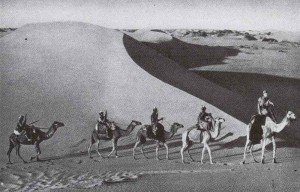
As an imperial power Italy employed colonial troops in a number of capacities. The best troops for desert warfare were the Sahariani who were completely mechanized, having their own complement of motorized artillery. Most of Italy’s colonial troops were poorly armed and untrained for modern warfare.
In Libya the Royal Corps of Libyan Troops was raised consisting of infantry and cavalry units. The two infantry divisions were destroyed in the fighting of 1940-41 and were only partially reformed, existing only as administrative depots. The cavalry was organized in groups of squadrons consisting of a headquarters and four squadrons of 150 men each.
The motorised saharan troops (Compagnia Sahariana) consisted of six companies organized as follows:
- a headquarters platoon;
- two or three machine gun platoons;
- an anti-tank platoon;
- a reconnaissance section of two to three Ghibli aircraft.
The strength of the company comprised 147 men, 20 motor transport vehicles, eight heavy machine guns and two 47mm anti-tank guns.
Camel-mounted troops were employed by the Saharan Command for desert patrol purposes and consisted of two companies, each of 280 men, four machine guns and 12 automatic rifles.
Fascist Militia
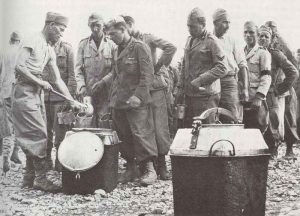
Roughly equivalent to the German Waffen-SS was the Italian Fascist Militia (Milizia Volontaria Per La Sicurezza Nationale or MVSN) more popularly known as the ‘Black Shirts’. This fascist para-military organization was formed in 1922 by Mussolini from the bands of ex-servicemen known as Squadristi.
The Commanding General of the MVSN was Mussolini himself while executive command was exercised by a chief-of-staff, who, during wartime, came under the command of the Italian Army. In imitation of the old Roman Army the MSVN adopted antiquated designations for its organization:
Zona (Division), Gruppo (Brigade), Legion (Regiment), Coorte (Battalion), Centuria (Company), Manipolo (Platoon), Squadra (Section).
Ranks were similarly arranged: a Console commanded a regiment, and a Centurione a company. A Legion was composed of 3 cohorts and a cohort had 3 centuries.
The Militia was organized into 14 Zonal Commands (roughly equivalent to Army Corps areas), and there were 133 Legions each with two battalions (one of men aged between 21 and 36 and a second territorial battalion with men up to the age of 55). The average strength of a legion was intended to be 1300 men, but legions were usually under strength for one reason or another. Total strength at the outbreak of war was estimated at 340,000 men.
At the beginning of the war three Black Shirt divisions were formed, while a number of battalions went to reinforce infantry divisions. Black shirts had served in Abyssinia and Spain, and fought on all the WW2 fronts Italy engaged in. The remaining Militiamen served as Army auxiliaries or in the special Militias: these were the Railways, Port, Post and Telegraph, Forestry, Anti-Aircraft and Coastal Defense, Frontier and University Militias. With the collapse of the Fascist regime in July 1943 the MVSN was disbanded.
Basic Italian Army units 1940 (A):
| Infantry division | Alpine division | Mobile division | |
|---|---|---|---|
| Total units | 59 + 3 Black Shirts | 6 | 3 |
| Infantry regiments | 2 (each 3 battalions) with 3,279 men each + most 1 Blackshirt Legion (2 battalions) with 1,693 men | 2 (4,757 men each) | 1 (Bersaglieri with 2,727 men) + motor cycle company (178 men) + 2 Cavalry regiments (878 men each) |
| Total men | 13,500 | 15,219 | 7,739 |
| Machine guns | 276 (60 heavy) | 216 (54 heavy, 162 light) | c. 132 (24 heavy, 108 light) |
| Mortars | 174 (30 x 81mm, 144 x 45mm) | 58 (34 x 40mm, 24 x 81mm) + 54 flamethrowers | c. 60 (6 x 81mm, 54 x 45mm) |
| Anti-tank guns | 24 (47mm) | - | 16 (47mm) |
| Anti-aircraft guns | 8 (20mm) | - | ? |
| Artillery | 36 (24 x 75mm, 12 x 100mm - some 'mountain infantry divisions' only 36 x 75mm howitzers) | 24 (75mm mountain howitzers) | 36 (24 x 75mm, 12 x 100mm) |
| Vehicles | - | (4,000 mules) | 218 trucks |
| Tanks | - | - | c. 46 (light tanks) |
Basic Italian Army units 1940 (B):
| Motorized division | Armoured division | |
|---|---|---|
| Total units | 2 | 3 |
| Infantry regiments | 2 (1,160 men each) + 1 Bersaglieri regiment (1,827) | 1 Bersaglieri (1,827) |
| Total men | 9,216 ? | |
| Machine guns | ? | c. 132 (24 heavy, 108 light) |
| Mortars | 36+ (81mm) | 9 (81mm) |
| Anti-tank guns | 24 - 40 (47mm) | 24 (24 x 47mm towed) |
| Anti-aircraft guns | 16 - 24 (20mm) | 26 (20mm) |
| Artillery | 36 (24 x 75mm, 12 x 100mm) | 70 (24 x 75mm, 18 x 105mm, 8 x 90mm towed guns) |
| Vehicles | ? | ? |
| Tanks | 46 (light tanks) | 165 (light Carro Veloce CV33, M11/39, Fiat 3000) |
Deployment of troops outside of Italy
- in Libya: 9 regular infantry divisions, 3 Blackshirt divisions, 2 native colonial divisions (250,000 men);
- in East Africa: 288,000 – 350,000 men (88,000 Italian troops, others native colonial troops);
- in Albania against Greece from 28 October 1940: 162,000 men (9th and 11th Army with 7 infantry, 1 alpine and 1 armored division)
References and literature
The Armed Forces of World War II (Andrew Mollo)
World War II – A Statistical Survey (John Ellis)
The Desert War (Andrew Kershaw, Ian Close)
Rommels Afrika Korps, Tobruk bis El Alamein (Pier Paolo Battistelli, Dr. Duncan Anderson)
Rommels Wüstenarmee (Martin Windrow)



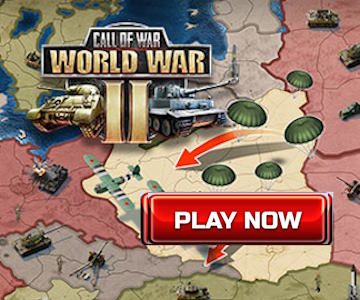
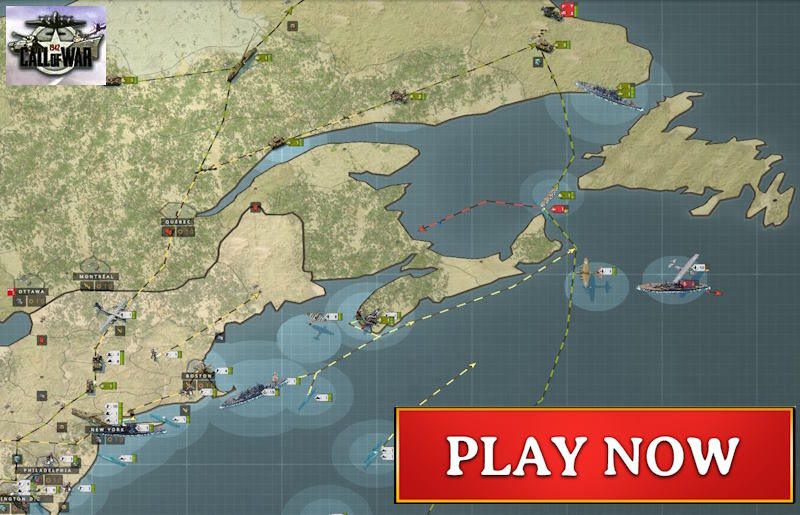




Contrary to popular myth, the Italians actually didn’t do all that badly. It is a myth to believe that the Italians couldn’t fight well and their weapons were poor. Their aircraft and ships were actually quite good, comparable to anything the British had.
After some initial defeats, the Italians actually improved their combat effectiveness, winning several important battles in North and East Africa and in the Mediterranean in general.
My hat goes off to them for staying in the fight for 5 years under very difficult circumstances and shortages.
The Italian army had fighting very fierce against
the enemy forces in all of the fronts during the
war from 1940 until 1945,the most big problem of the
Italian army at the time was the organization, and
equipments, If we had better high command and
more equipments, the Italian army will fighting
better.